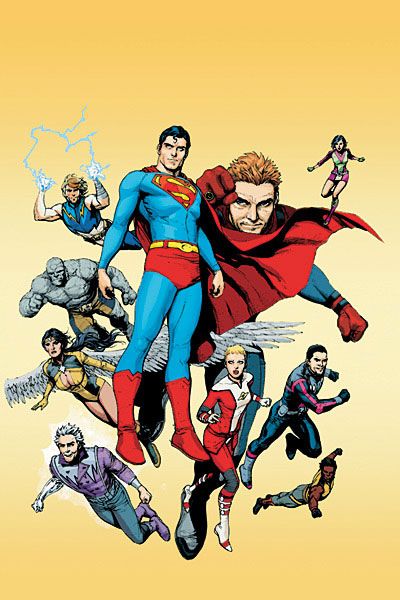I was first introduced to the Legion of Super-Heroes in a Superman crossover comic book, the highly inconsistent but occasionally wonderful "DC Comics Presents." Now, here I am over two decades later, telling you that the best Legion story in recent memory hasn't been told in its own comic, but in another Superman title: "Action Comics" #863.
Geoff Johns understands the iconic heroes of the DC Universe. His current work on "Green Lantern" has amplified the cosmic proportions of that series and turned it into the space-opera-with-a-heart that it always aspired to be. Here, in "Action Comics," he presents a Superman who is confident, assured, and kind. A super MAN who will do what's right because it's right, and he will do so with all of the resources at his disposal. Johns' work on this title, sometimes with collaborator Richard Donner, and sometimes without, has provided scenarios in which Superman can be examined in relation to others with similar powers. First it was Chris Kent, the Phantom Zone child and surrogate son of Superman. Then it was Bizarro, the twisted doppelganger. And now it is the entire Legion of Super-Heroes and the villainous Earth-Man, a fascist with the power of the entire Legion at his disposal.
With Chris Kent (in a storyline that, at this writing, has remained unresolved after seemingly endless delays), Superman's paternal side takes the fore. With Bizarro, he's the straight man in an absurd world. With the Legion, Superman is the inspiration for everything, the beacon of everything pure and good in a world corrupted by xenophobia and narrow-mindedness.
Make no mistake about it, while the conclusion of this six-part Legion story arc is a definitive Legion tale, it's also the story of who Superman is, and why he's so important. Johns doesn’t take the metafictional route of "All-Star Superman," which places the Man of Steel in the supercontext as a god-like creature inspiring humanity from a higher plane of existence. Rather, Johns works within the architecture of DC continuity, or DC continuity as it should be, where nothing is excluded, and everything is part of the vast tapestry of permutations and revisions. The Legion presented in this story is certainly not the Legion as currently published in the comic bearing its name, and it's not exactly an older version of the once-popular Paul Levitz version of the team. It's Johns' version of that Legion -- an idealized, iconic version -- that reminds us of how thrilling the concept of an entire Legion of Super-Heroes can be.
When Superman hovers in the air on the double-page splash in the center of the issue, with eighteen Legionnaires flying down from above, we must recognize the majesty of such an occasion. It's a moment that signifies that the Legion is back. Not just in the context of this story, where they've just risen from the metaphorical ashes to regain their status as heroes, but in the context of the DC Universe, where their impact has diminished to insignificance over the past decade.
And they wouldn't be who they are without Superman.
And, as Johns seems to imply, Superman wouldn't be who he is without them. As he says when he defeats the ridiculous Earth-Man, "I've been an outsider every day of my life." Not when he was with the Legion, though. For those moments, both past, present, and 1,000 years in the future, Superman belonged. And in those moments, surrounded by dozens of peers with special powers, Superman could feel like a human.

